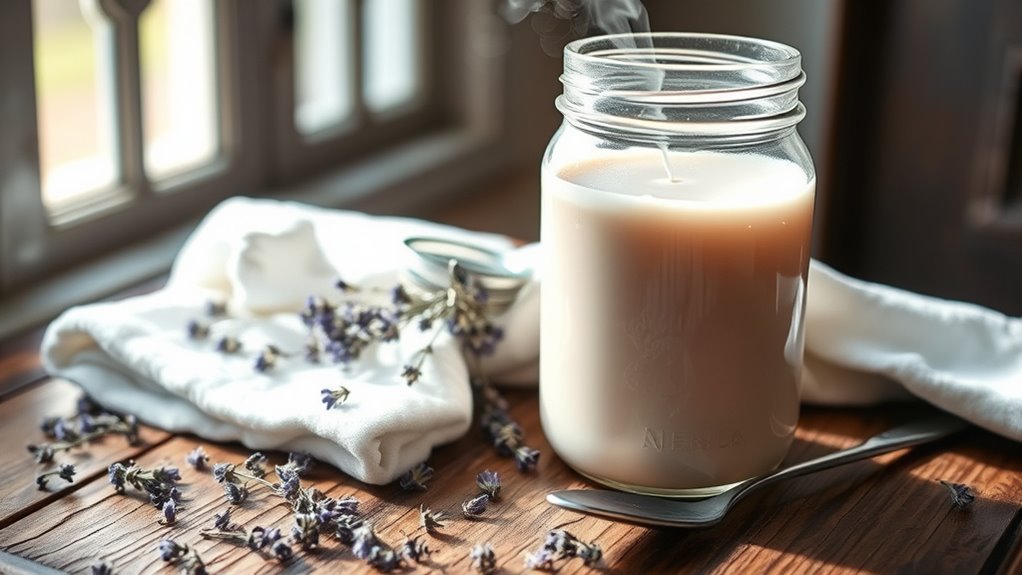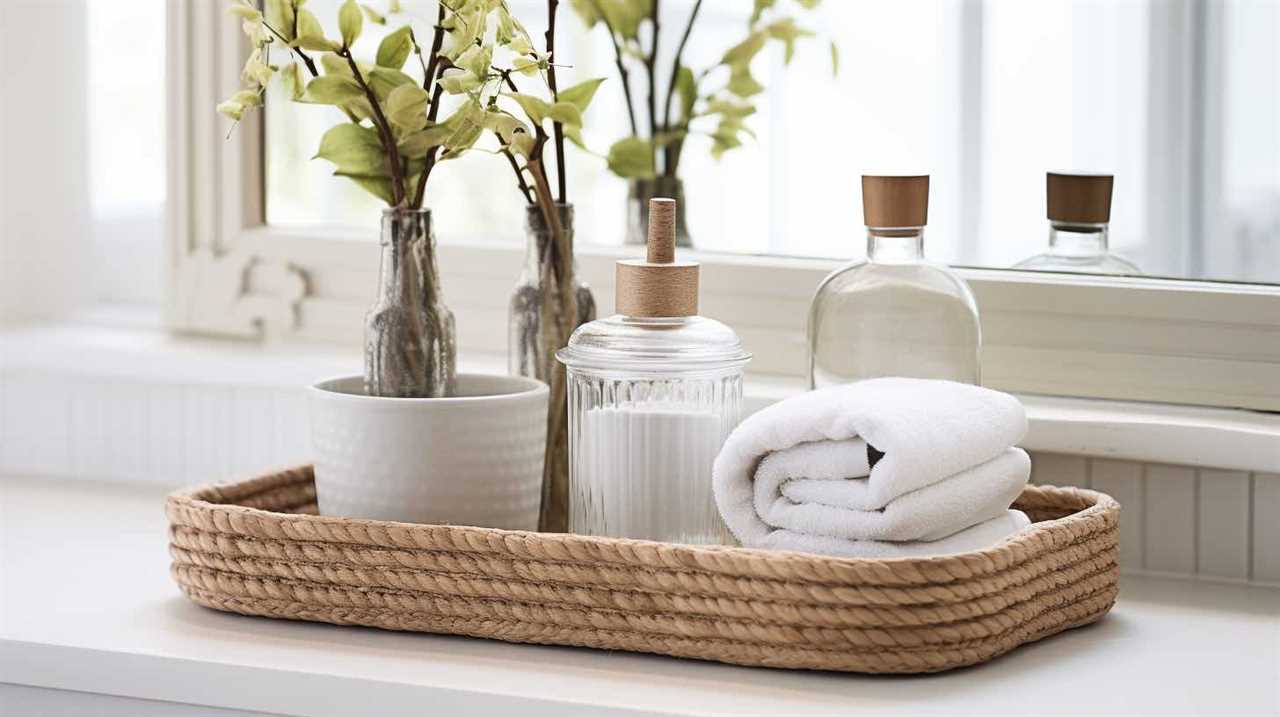When you add milk to your bath, its natural proteins, fats, vitamins, and minerals dissolve in warm water, creating a nourishing layer on your skin. The proteins help repair skin, while fats lock in moisture and protect against irritants. Vitamins promote skin renewal, and minerals support overall health. This simple chemistry guarantees deep hydration and gentle exfoliation. Keep exploring how these ingredients work together to transform your bath into a luxurious skincare experience.
Key Takeaways
- Warm water dissolves milk solids, releasing proteins and fats that nourish and hydrate the skin.
- Milk proteins form a protective, emollient layer, enhancing skin softness and elasticity.
- Fats and lipids create a barrier that shields the skin from environmental irritants.
- Natural sugars and vitamins gently exfoliate dead skin cells, promoting renewal.
- Additional ingredients like honey and oats boost hydration, soothe inflammation, and support overall skin health.

A homemade milk-bath soak is a luxurious way to nourish your skin and create a relaxing at-home spa experience. When you choose to craft your own bath soak, you’re embracing the indulgence of a luxury spa while using natural ingredients that are gentle and effective. The science behind why milk makes such a soothing addition lies in its unique composition, which interacts with your skin to deliver both hydration and calming benefits. Milk contains proteins, fats, vitamins, and minerals that work together to improve skin softness and elasticity. These natural ingredients help to repair the skin barrier, reduce inflammation, and promote a more radiant appearance.
Indulge in a nourishing milk bath for soft, radiant, and relaxed skin at home.
The proteins in milk, especially casein and whey, act as natural emollients. When dissolved in warm water, they form a nourishing layer on your skin’s surface, locking in moisture and preventing dryness. This is why milk baths have been treasured for centuries for their ability to soften and smooth the skin. Fats and lipids in milk further enhance this effect by creating a protective barrier that shields against environmental irritants, making it an ideal choice for sensitive or irritated skin. Plus, the vitamins found in milk—like vitamin A, D, and B12—help to rejuvenate skin cells, giving your skin a healthier glow after each soak.
Using natural ingredients in your homemade milk-bath soak amplifies these benefits. For example, honey adds humectant properties, drawing moisture into your skin, while oatmeal can soothe itching and inflammation. Essential oils like lavender or chamomile not only impart a calming aroma but also contain antioxidants that support skin health. These natural ingredients work synergistically, enriching the bath experience and elevating it from simple hydration to a holistic spa treatment.
When you prepare your milk-bath, you’re not just combining ingredients—you’re creating a personalized skincare ritual rooted in chemistry. The warmth of the water dissolves the milk solids, releasing proteins and fats that penetrate your skin, providing deep nourishment. The natural sugars and vitamins from milk also help to gently exfoliate, removing dead skin cells and revealing a fresher layer underneath. By opting for natural ingredients, you avoid harsh chemicals and synthetic fragrances often found in commercial bath products, making your homemade soak a truly pure and gentle pampering experience.
In essence, the science behind homemade milk-bath soaks explains why they work so well. The well-balanced chemistry of milk’s natural compounds interacts with your skin to promote moisture, repair, and relaxation—all essential for a luxurious spa-like experience at home. With a few simple ingredients and a bit of patience, you can craft a nourishing bath that leaves your skin feeling soft, smooth, and revitalized, proving that sometimes, the simplest ingredients are the most powerful.
Frequently Asked Questions
Can I Customize Milk-Bath Soaks for Different Skin Types?
Yes, you can customize milk-bath soaks for different skin types by exploring various customization options and skin-specific formulations. For dry skin, add nourishing ingredients like oatmeal or honey. If you have sensitive skin, opt for gentle, fragrance-free options with soothing botanicals. For oily skin, include ingredients like clay or tea tree oil. Adjusting the ingredients allows you to create effective, personalized milk-bath soaks tailored to your skin’s unique needs.
How Long Do Homemade Milk-Bath Soaks Typically Last?
You might wonder how long your homemade milk-bath soaks last, and honestly, it depends. Typically, their shelf life ranges from one to two weeks if refrigerated properly. Store them in an airtight container away from direct sunlight, and you’ll keep the freshness intact. Keep in mind, the clock starts ticking once you prepare it, so use your bath soak within that time frame to enjoy its nourishing benefits without worry.
Are There Any Safety Concerns With Adding Essential Oils?
When adding essential oils to your milk-bath, guarantee proper essential oil dilution to prevent skin irritation. Always do a patch test first and follow allergy precautions, especially if you have sensitive skin or allergies. Use only a few drops and mix well. Avoid direct contact with eyes or mucous membranes. If you’re unsure about a specific oil, consult a professional to keep your bath safe and enjoyable.
What Are the Benefits of Using Different Types of Milk?
Using different types of milk in your bath offers various benefits. For example, whole milk provides nutritional benefits like vitamins and minerals that nourish your skin, while goat’s milk contains lactic acid that gently exfoliates. These milks also have skin soothing properties, helping to calm irritation and moisturize. You can choose the type based on your skin’s needs, ensuring a more customized and relaxing bath experience.
Can I Store Milk-Bath Soaks for Future Use?
You can store milk-bath soaks for future use, but be mindful of storage duration and shelf life. Keep them in airtight containers in a cool, dark place to prevent spoilage. Typically, they last about one to two months if properly stored. Check for any changes in smell or appearance before use, and discard if you notice mold or an off scent to guarantee your bath remains safe and enjoyable.
Conclusion
Now that you know the simple chemistry behind homemade milk-bath soaks, you’re all set to craft your own luxurious treatment. With just a few ingredients, you can turn a regular bath into a soothing escape. Remember, the proof is in the pudding—sometimes, the most straightforward solutions are the best. So go ahead, indulge yourself and let the natural magic work its charm. After all, a little pampering can go a long way in making you feel renewed.










